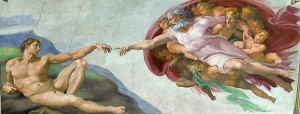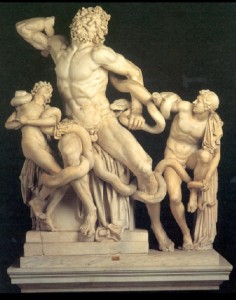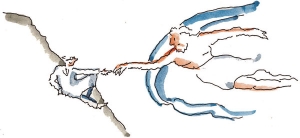
R. O. Blechman (b. 1930)|Modern Laocoön|Cover illustration for The New Yorker (December 17, 1990)|The New Yorker; Copyright © Condé Nast
For his 1990 holiday season cover for The New Yorker, Blechman borrowed from the sculptural form of the ancient marble group of Laocoön and His Sons. That sculpture depicts a Trojan priest and his sons being punished by the gods for warning his countrymen about the Greek’s Trojan horse that would invade the city. Probably carved in the 1st century B.C. and perhaps based on an earlier Greek bonze figure, the Laocoön was rediscovered in Rome in the early 16th century. The sculpture’s influence is immense, in part because it was praised by the first-century writer Pliny the Younger. So highly regarded was it that not long after its discovery, Pope Julius II brought the group into the Vatican collections. It has been appropriated and reinterpreted by many other artists including William Blake and Charles Dickens. Blechman’s twist (literal and figural) is to posit a modern version of the image with father and sons balancing on wrapped packages, and bound together by holiday ribbons and Christmas lights. While many Renaissance period Italians knew of the group’s finding and the honor in which this work of art was held, in the 20th century it is familiar predominantly by those who study art history.

Michelangelo (1475-1564)|Creation of Adam, c. 1508-12|fresco|From the Sistine Chapel, The Vatican, Rome
Just recently, Blechman’s illustrations enlivened an article entitled, “The Great Proton Smashup” in the Sunday New York Times Week in Review section. The answer to the first question in this article is about what a particle physicist does—“smash things together and watch what comes tumbling out.” To illustrate the overarching concept of creation, Blechman references one of the most often shown portions of Michelangelo’s Sistine Chapel ceiling: the image of God passing the spark of life to Adam. Michelangelo’s Creation of Adam portion of the ceiling fresco shows a partially reclining Adam on the earth languidly reaching out to the energizing hand of God who, wearing a modest shift, floats in the firmament with a host of heavenly creatures (including Eve) behind him. Blechman has covered God modestly with a skirt while the partially reclining Adam wears glasses, a gray suit, black tie, and white shirt. This is a mutable Adam, no longer passive, who not only comes to life, but appears ready to get on with it. Blechman’s image of creation joins a myriad of other works that quote Michelangelo’s.**
The reuse of another’s art as a source for something new, is as old as art itself. The traditional education of artists employed copying the work of others serving as a means to understanding their composition and technique. What strikes me as a curious juxtaposition of awareness versus obliviousness is the modern habit of using other older art in the construction of advertising, cartoons, in addition to new art, for an audience that may or may not understand the source for the image. Reuse of art on a broad scale implies a visual fluency with the art of the past that we don’t necessarily believe common in our society. That said, by finding my examples of this phenomena on covers of The New Yorker or in the pages of The New York Times, I have chosen sources for these sorts of images whose readers and viewers are perhaps likely to have a broader and deeper visual education than in the population at large. This same exercise should perhaps be performed by examining similar illustrations found in the pages of other more popular magazines for a better assessment of visual literacy.
The visual success of these and other of Blechman’s work of this type is squarely based on a high level of visual familiarity with earlier art work. *** As we sit here at our early 21st century computer screens, perhaps we possess a broader knowledge of visual references than we give ourselves credit.
* In May of 1990, Blechman reconstructed Whistler’s painting of his mother, Arrangement in Grey and Black: The Artist’s Mother, 1871 for his mother’s day New Yorker cover; his October 7, 1991 New Yorker cover is a play on Rodin’s sculpture The Thinker, 1902. In 1990 and 1991 there were a total of ten New Yorker covers by Blechman and other cover artists that referenced earlier art.
**Including Steve Spielberg’s use of the gesture in his 1982 hit movie, E. T.: The Extra-Terrestrial.
*** A quick study of New Yorker covers viewed at Cover Browser (https://www.coverbrowser.com/) yields an interesting overview. Between 1944 and 1989 (45 years), I counted only 7 New Yorker covers that use earlier art as the source for their cover image. But between 1990 and 2007 (17 years), I counted at least 27 New Yorker covers that harken back to art by others.
May 13, 2010
By Joyce K. Schiller, Curator, Rockwell Center for American Visual Studies
at the Norman Rockwell Museum








